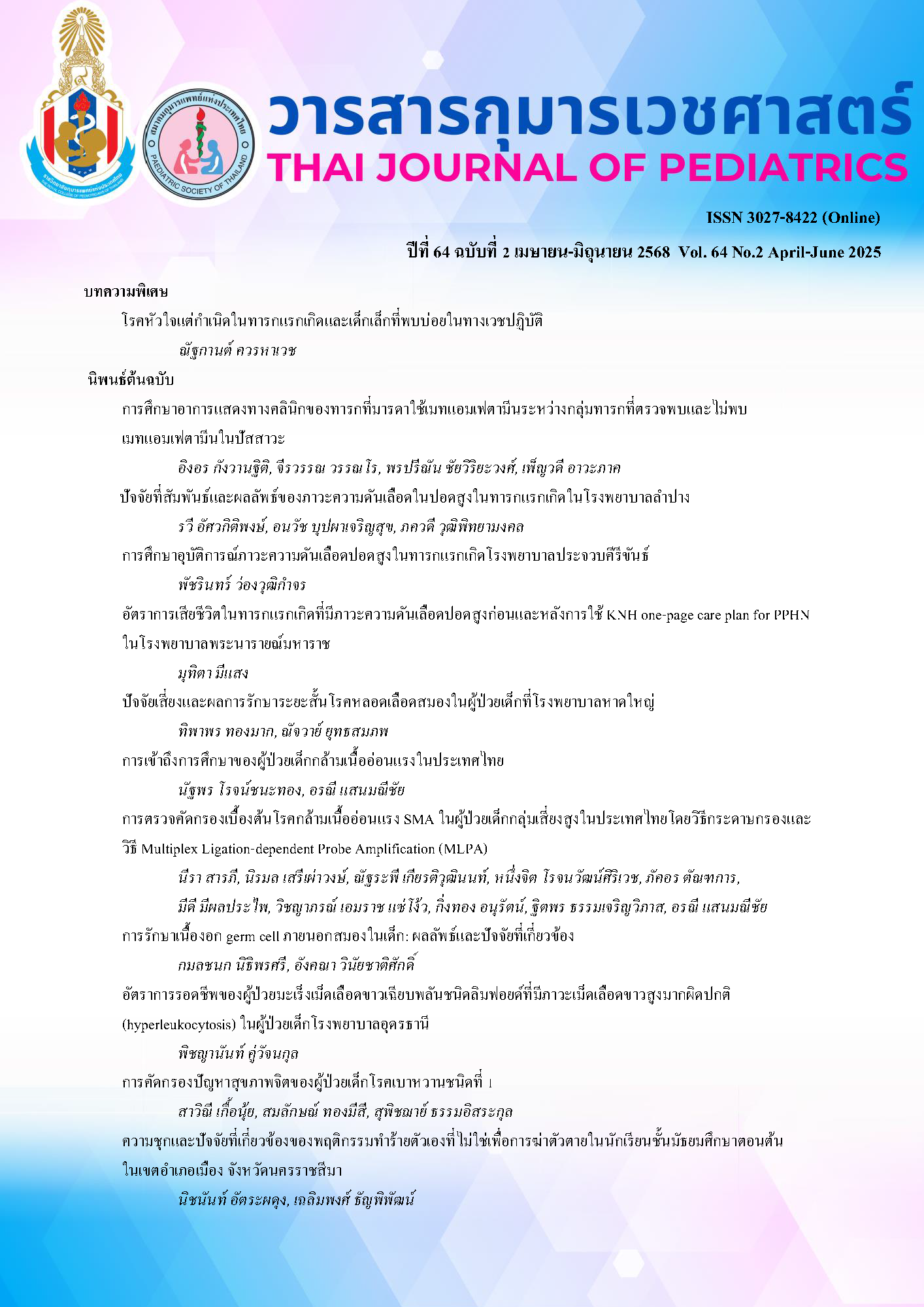Associated factors and outcomes of persistent pulmonary hypertension of the newborn in Lampang hospital
Keywords:
persistent pulmonary hypertension of the newborns, respiratory distress in newborns, maternal health conditionsAbstract
Background: The study of risk factors for persistent pulmonary hypertension of the newborns can help develop guidelines for monitoring, diagnosis, and treatment to reduce morbidity and mortality, as well as improve healthcare systems in health districts.
Objective: To study the factors associated with persistent pulmonary hypertension of the newborns and the outcomes of treatment.
Method: A retrospective study was conducted to compare the persistent pulmonary hypertension of the newborns with other causes of respiratory distress from 2018 to 2024. Multivariable risk difference regression analysis was used to analyze factors affecting persistent pulmonary hypertension of the newborns.
Results: Factors affecting persistent pulmonary hypertension of the newborns included cesarean delivery (RR 1.92; 95%CI 1.17, 3.13), meconium aspiration syndrome (RR 3.46; 95%CI 1.97, 6.08), neonatal sepsis (RR 2.53; 95%CI 1.51, 4.23), pulmonary hemorrhage (RR 2.47; 95%CI 1.39, 4.37), pneumothorax (RR 2.33; 95%CI 1.41, 3.84), and heart failure due to patent ductus arteriosus (RR 4.85; 95%CI 3.16, 7.46). The group with persistent pulmonary hypertension of the newborns required more inotropic drugs, vasodilators, and high-frequency ventilation. They had longer ventilation times, longer hospital stays, and higher mortality rates, all of which were statistically significant.
Conclusion: The method of delivery, conditions affecting the heart and lungs, and bloodstream infections were associated with pulmonary hypertension. Therefore, controlling these factors might help reduce persistent pulmonary hypertension of the newborns, which could impact disability and mortality.
Downloads
References
Singh Y, Lakshminrusimha S. Pathophysiology and management of persistent pulmonary hypertension of the newborn. Clin Perinatol. 2021;48:595–618.
Jastania EI, Alqarni MS, Abukhodair AW, Bukhari ZM, Bukhari RA, Khatrawi S, et al. Risk factors of persistent pulmonary hypertension in neonate in a tertiary care referral center. Cureus. 2022;14:e22416.
Kaveh M, Mahboobipour AA, Bitaraf A, Shojaei M, Mohammadpour Ahranjani B, Majidi B, et al. A prospective study of neonates with persistent pulmonary hypertension of the newborn (PPHN): Prevalence, clinical outcomes, and risk factors. IJN. 2022;13:112-9.
Nakwan N, Jain S, Kumar K, Hosono S, Hammoud M, Elsayed YY, et al. An Asian multicenter retrospective study on persistent pulmonary hypertension of the newborn: Incidence, etiology, diagnosis, treatment and outcome. J Matern Fetal Neonatal Med. 2020;33:2032–7.
ชรินพร พนาอรุณวงศ์. ภาวะความดันเลือดปอดสูงในทารกแรกเกิดในโรงพยาบาลนครพนม. วารสารโรงพยาบาลนครพนม. 2560;4:5-18.
Nakwan N, Pithaklimnuwong S. Acute kidney injury and pneumothorax are risk factors for mortality in persistent pulmonary hypertension of the newborn in Thai neonates. J Matern Fetal Neonatal Med. 2016;29:1741-6.
ดวงหทัย พึ่งสุวรรณ. อุบัติการณ์และปัจจัยที่มีผลต่อการเกิดภาวะความดันเลือดในปอดสูงในทารกแรกเกิดของโรงพยาบาลหัวหิน. หัวหินเวชสาร. 2566;3:1-13.
Hernández-Díaz S, Van Marter LJ, Werler MM, Louik C, Mitchell AA. Risk factors for persistent pulmonary hypertension of the newborn. Pediatrics. 2007;120:e272-82.
Zhou R, Zheng YN, Zhang XY, Cheng YY. A Meta-analysis of the risk factors of persistent pulmonary hypertension in newborns. Front Pediatr. 2021;9:659137.
Yelamali BC, Mirji GS, Rajput M. A retrospective study of predisposing factors and outcome of persistant pulmonary hypertension among newborns at rural tertiary care centre. Int J Contemp Pediatr. 2020;8:92.
Mat Bah MN, Tan RYH, Razak H, Sapian MH, Abdullah N, Alias EY. Survival and associated risk factors for mortality among infants with persistent pulmonary hypertension of the newborn in Malaysia. J Perinatol. 2021;41:786–93.
Winovitch KC, Padilla L, Ghamsary M, Lagrew DC, Wing DA. Persistent pulmonary hypertension of the newborn following elective cesarean delivery at term. J Matern Fetal Neonatal Med. 2011;24:1398–402.
Lakshminrusimha S, Keszler M. Persistent pulmonary hypertension of the newborn. Neo Reviews. 2015;16:e680–92.
Singh Y. Evaluation of a child with suspected congenital heart disease. Paediatrics and Child Health. 2018;28:556–61.
Sharma V, Berkelhamer S, Lakshminrusimha S. Persistent pulmonary hypertension of the newborn. Matern Health Neonatol Perinatol. 2015;1:14.
Cassin S, Dawes GS, Mott JC, Ross BB, Strang LB. The vascular resistance of the foetal and newly ventilated lung of the lamb. J Physiol. 1964;171:61–79.
Ball MK, Seabrook RB, Bonachea EM, Chen B, Fathi O, Nankervis CA, et al. Evidence-based guidelines for acute stabilization and management of neonates with persistent pulmonary hypertension of the newborn. Am J Perinatol. 2023;40:1495–508.
Nair J, Lakshminrusimha S. Update on PPHN: Mechanisms and treatment. Semin Perinatol. 2014;38:78–91.
Neonatal Inhaled Nitric Oxide Study Group. Inhaled nitric oxide in full-term and nearly full-term infants with hypoxic respiratory failure. N Engl J Med. 1997;336:597–604.
Babooa N, Shi WJ, Chen C. Factors relating caesarean section to persistent pulmonary hypertension of the newborn. World J Pediatr. 2017;13:517–27.
Choudhary M, Meena MK, Chhangani N, Sharma D, Choudhary JS, Choudhary SK. To study prevalence of persistent pulmonary hypertension in newborn with meconium aspiration syndrome in western Rajasthan, India: A prospective observational study. J Matern Fetal Neonatal Med. 2016;29:324–7.
Deshpande S, Suryawanshi P, Holkar S, Singh Y, Yengkhom R, Klimek J, et al. Pulmonary hypertension in late onset neonatal sepsis using functional echocardiography: A prospective study. J Ultrasound. 2022;25:233–9.
Gentle SJ, Travers CP, Clark M, Carlo WA, Ambalavanan N. Patent ductus arteriosus and development of bronchopulmonary dysplasia–associated pulmonary hypertension. Am J Respir Crit Care Med. 2023;207:921–8.
สุภาณี ชนิทร์วณิชย์. ภาวะความดันเลือดในปอดสูงในทารกแรกเกิด โรงพยาบาลระยอง [อินเทอร์เน็ต]. [สืบค้นเมื่อ 14 ม.ค. 2568]. https://www.rayonghospital.go.th/images/webpage/d0a7a6da175e33.pdf
Gezmu AM, Tefera E, Mochankana K, Imran F, Joel D, Pelaelo I, et al. Pulmonary hemorrhage and associated risk factors among newborns admitted to a tertiary level neonatal unit in Botswana. Front Pediatr. 2023;11:1171223.
มนัญญา อภิวัฒนพร. ภาวะความดันเลือดในปอดสูงในทารกแรกเกิดในโรงพยาบาลศูนย์อุดรธานี. วารสารการแพทย์โรงพยาบาลอุดรธานี. 2564;29:30-7.
อุษากร แต้ศิริ. ภาวะความดันเลือดปอดสูงในทารกแรกเกิด ปัจจัยที่สัมพันธ์กับการเสียชีวิตและตัวทำนายการเสียชีวิต. วารสารกุมารเวชศาสตร์. 2564;60:227-37.
Totaro RJ, Raper RF. Epinephrine-induced lactic acidosis following cardiopulmonary bypass. Crit Care Med. 1997;25:1693–9.
McNamara PJ, Laique F, Muang-In S, Whyte HE. Milrinone improves oxygenation in neonates with severe persistent pulmonary hypertension of the newborn. Journal of Critical Care. 2006;21:217–22.
Rawat M, Chandrasekharan PK, Williams A, Gugino S, Koenigsknecht C, Swartz D, et al. Oxygen saturation index and severity of hypoxic respiratory failure. Neonatology. 2015;107:161–6.
Downloads
Published
How to Cite
Issue
Section
License
Copyright (c) 2025 The Royal College of Pediatricians Of Thailand

This work is licensed under a Creative Commons Attribution-NonCommercial-NoDerivatives 4.0 International License.


